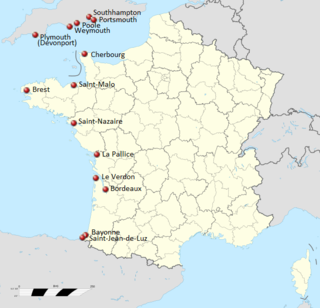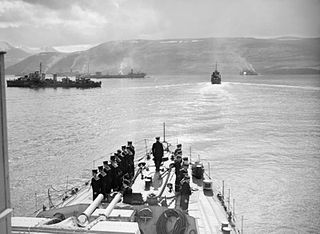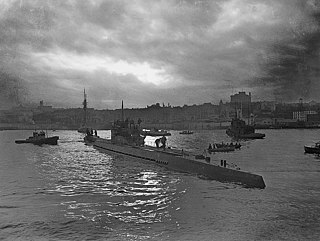 W
WOperation Aerial was the evacuation of Allied forces and civilians from ports in western France from 15 to 25 June 1940 during the Second World War. The evacuation followed the Allied military collapse in the Battle of France against Nazi Germany. Operation Dynamo, the evacuation from Dunkirk and Operation Cycle, an embarkation from Le Havre, finished on 13 June. British and Allied ships were covered from French bases by five Royal Air Force (RAF) fighter squadrons and assisted by aircraft based in England, to lift British, Polish and Czech troops, civilians and equipment from Atlantic ports, particularly from St Nazaire and Nantes.
 W
WThe Aleutian Islands campaign was a military campaign conducted by the United States and Japan in the Aleutian Islands, part of the Territory of Alaska, in the American Theater and the Pacific Theater of World War II starting on June 3, 1942. In the only two invasions of the United States during the war, a small Japanese force occupied the islands of Attu and Kiska, where the remoteness of the islands and the challenges of weather and terrain delayed a larger American-Canadian force sent to eject them for nearly a year. The islands' strategic value was their ability to control Pacific transportation routes and so US General Billy Mitchell stated to the U.S. Congress in 1935, "I believe that in the future, whoever holds Alaska will hold the world. I think it is the most important strategic place in the world."
 W
WThe Battle of the Atlantic, the longest continuous military campaign in World War II, ran from 1939 to the defeat of Nazi Germany in 1945, covering a major part of the naval history of World War II. At its core was the Allied naval blockade of Germany, announced the day after the declaration of war, and Germany's subsequent counter-blockade. The campaign peaked from mid-1940 through to the end of 1943.
 W
WThe Battle of the Audierne Bay was an engagement between German and Allied naval flotillas that took place on 23 August 1944, during World War II. Three Allied warships, which had already established control off the coast of Brittany and were lurking off Audierne south of the invested fortress of Brest, intercepted and sank eight German vessels of an armed convoy. This was the conclusion of Operation Kinetic; an allied plan to intercept shipping and hinder Germans besieged at Brest.
 W
WThe Battle of the Bay of Biscay, or Operation Bernau, was a naval action that took place on 28 December 1943 during World War II as part of the Atlantic campaign. The battle took place in the Bay of Biscay between two light cruisers of the British Royal Navy, and a destroyer and a torpedo boat flotilla of the German Kriegsmarine hoping to intercept and escort a blockade runner. The battle was fought as part of the Allied Operation Stonewall which was to intercept German blockade runners off the west coast of France. In the confused action that followed the two British cruisers HMS Enterprise and HMS Glasgow respectively sank T26, together with her sister ship T25 and the destroyer Z27.
 W
WBlack May refers to a period in the Battle of the Atlantic campaign during World War II, when the German U-boat arm (U-Bootwaffe) suffered high casualties with fewer Allied ships sunk; it is considered a turning point in the Battle of the Atlantic.
 W
WThe Battle of the Caribbean refers to a naval campaign waged during World War II that was part of the Battle of the Atlantic, from 1941 to 1945. German U-boats and Italian submarines attempted to disrupt the Allied supply of oil and other material. They sank shipping in the Caribbean Sea and the Gulf of Mexico and attacked coastal targets in the Antilles. Improved Allied anti-submarine warfare eventually drove the Axis submarines out of the Caribbean region.
 W
WConvoy Faith was a small, fast Allied convoy of World War II. It suffered heavy casualties when attacked by German Focke-Wulf Fw 200 Condor long-range bombers while en route from Britain to West Africa in July 1943. The convoy comprised two large troopships and a freighter, later joined by two destroyers and two frigates as escorts at various dates after it sailed on 7 July 1943. The two troopships, SS California and SS Duchess of York, both former liners, were carrying military personnel to West Africa, where locally recruited troops were to be embarked as reinforcements for the Allied forces in Burma and the Middle East. The freighter MV Port Fairy, carrying ammunition, was ultimately bound for Australia and New Zealand via the Panama canal.
 W
WConvoy HX 212 was the 212th of the numbered series of World War II HX convoys of merchant ships from HalifaX to Liverpool. The ships departed New York City on 18 October 1942 and were met on 23 October by Mid-Ocean Escort Force Group A-3 consisting of the United States Coast Guard Treasury-class cutter USCGC Campbell, the destroyer Badger and the Flower-class corvettes Dianthus, Rosthern, Trillium, Dauphin, Alberni, Summerside and Ville de Quebec. The first five escorts had worked together previously, but the last three corvettes were attached to the convoy only for passage to the eastern Atlantic in preparation for assignments on Operation Torch. Summerside was the only escort equipped with modern Type 271 centimeter-wavelength radar.
 W
WConvoy JW 55B was an Arctic convoy sent from Great Britain by the Western Allies to aid the Soviet Union during World War II. It sailed in late December 1943, reaching the Soviet northern ports at the end of the month. All ships arrived safely.
 W
WConvoy JW 56B was an Arctic convoy sent from Great Britain by the Western Allies to aid the Soviet Union during World War II. It sailed in late January 1944, reaching the Soviet northern ports at the beginning of February. All ships arrived safely. During the voyage JW 56B was attacked by a German U-boat force; no merchant ships were sunk, though one of the escorts was lost. One attacking U-boat was destroyed in the operation.
 W
WConvoy ON 92 was a trade convoy of merchant ships during the Second World War. It was the 92nd of the numbered series of ON convoys Outbound from the British Isles to North America. The ships departed from Liverpool on 6 May 1942 and were joined on 7 May by Mid-Ocean Escort Force Group A-3.
 W
WConvoy ON 127 was a trade convoy of merchant ships during the second World War. It was the 127th of the numbered series of ON convoys Outbound from the British Isles to North America and the only North Atlantic trade convoy of 1942 or 1943 where all U-boats deployed against the convoy launched torpedoes. The ships departed Liverpool on 4 September 1942 and were met at noon on 5 September by the Royal Canadian Navy Mid-Ocean Escort Force Group C-4 consisting of the Canadian River-class destroyer Ottawa and the Town-class destroyer St. Croix with the Flower-class corvettes Amherst, Arvida, Sherbrooke, and Celandine. St. Croix's commanding officer, acting Lieutenant Commander A. H. "Dobby" Dobson RCNR, was the senior officer of the escort group. The Canadian ships carried type 286 meter-wavelength radar but none of their sets were operational. Celandine carried Type 271 centimeter-wavelength radar. None of the ships carried HF/DF high-frequency direction finding sets.
 W
WConvoy ON 154 was a North Atlantic convoy of the ON series which ran during the battle of the Atlantic in World War II. It was the 154th of the numbered series of merchant ship convoys Outbound from the British Isles to North America. It came under attack in December 1942 and lost 13 of its 50 freighters. One of the attacking U-boats was destroyed.
 W
WConvoy ON 166 was the 166th of the numbered ON series of merchant ship convoys Outbound from the British Isles to North America. Sixty-three ships departed Liverpool 11 February 1943 and were met the following day by Mid-Ocean Escort Force Group A-3 consisting of the Treasury-class cutters Campbell and Spencer and the Flower-class corvettes Dianthus, Chilliwack, Rosthern, Trillium and Dauphin.
 W
WPQ 17 was the code name for an Allied Arctic convoy during the Second World War. On 27 June 1942, the ships sailed from Hvalfjörður, Iceland, for the port of Arkhangelsk in the Soviet Union. The convoy was located by German forces on 1 July, after which it was shadowed continuously and attacked. The First Sea Lord Admiral Dudley Pound, acting on information that German surface units, including the German battleship Tirpitz, were moving to intercept, ordered the covering force built around the Allied battleships HMS Duke of York and the USS Washington away from the convoy and told the convoy to scatter. Because of vacillation by Oberkommando der Wehrmacht, the Tirpitz raid never materialised. The convoy was the first large joint Anglo-American naval operation under British command; in Churchill's view this encouraged a more careful approach to fleet movements.
 W
WConvoy SC 94 was the 94th of the numbered series of World War II Slow Convoys of merchant ships from Sydney, Cape Breton Island, Nova Scotia, to Liverpool. The ships departed Sydney on 31 July 1942 and were met by Mid-Ocean Escort Force Group C-1.
 W
WConvoy SC 104 was the 104th of the numbered series of World War II Slow Convoys of merchant ships from Sydney, Cape Breton Island to Liverpool. During October 1942, a U-boat wolf pack sank eight ships from the convoy. The convoy escorts sank two of the attacking submarines.
 W
WConvoy SC 107 was the 107th of the numbered series of World War II Slow Convoys of merchant ships from Sydney, Cape Breton Island to Liverpool. The ships departed New York City on 24 October 1942 and were found and engaged by a wolfpack of U-boats which sank fifteen ships. It was the heaviest loss of ships from any trans-Atlantic convoy through the winter of 1942–43. The attack included one of the largest non-nuclear man-made explosions in history, when U-132 torpedoed ammunition ships SS Hobbema and SS Hatimura - both were sunk, one exploded, with the German submarine also being destroyed in the explosion.
 W
WConvoy SC 118 was the 118th of the numbered series of World War II Slow Convoys of merchant ships from Sydney, Cape Breton Island to Liverpool. The ships departed New York City on 24 January 1943 and were met by Mid-Ocean Escort Force Group B-2 consisting of V-class destroyers Vanessa and Vimy, the Treasury-class cutter Bibb, the Town-class destroyer Beverley, Flower-class corvettes Campanula, Mignonette, Abelia and Lobelia, and the convoy rescue ship Toward.
 W
WConvoy SC 121 was the 121st of the numbered series of World War II Slow Convoys of merchant ships from Sydney, Cape Breton Island to Liverpool. The ships departed New York City 23 February 1943; and were met by the Mid-Ocean Escort Force Group A-3 consisting of the United States Coast Guard (USCG) Treasury-class cutter USCGC Spencer, the American Wickes-class destroyer USS Greer, the British and Canadian Flower-class corvettes HMS Dianthus, HMCS Rosthern, HMCS Trillium and HMCS Dauphin and the convoy rescue ship Melrose Abbey. Three of the escorts had defective sonar and three had unserviceable radar.
 W
WConvoy SC 130 was a North Atlantic convoy which ran during the battle of the Atlantic in World War II. It was the 130th of the numbered series of Slow Convoys of merchant ships from Sydney, Cape Breton Island to Liverpool. SC 130 was one of several convoy battles that occurred during the crisis month of May 1943.
 W
WConvoy UGS-40 was an Allied merchant navy convoy with a military escort which sailed from Norfolk, Virginia on 22 April 1944, and passed through the Gibraltar Strait on 9 May 1944 on its way to Naples. The convoy was shadowed for two days by German aircraft. Allied Beaufighters were sent out ten times to attack the reconnaissance aircraft without success. After this, on 11 May, the convoy came under heavy air attack 50 miles east of Algiers. At least 19 German aircraft were shot down by the convoy while the Germans failed to hit a single Allied ship.
 W
WOperation Gauntlet was an Allied Combined Operation from 25 August until 3 September 1941, during the Second World War. Canadian, British and Free Norwegian Forces landed on the Norwegian island of Spitsbergen in the Svalbard Archipelago, 650 mi (1,050 km) south of the North Pole.
 W
WOperation Goodwood was a series of British carrier air raids conducted against the German battleship Tirpitz at her anchorage in Kaafjord in occupied Norway during late August 1944. It was the last of several attacks made by the Home Fleet during 1944 which sought to damage or sink Tirpitz and thereby eliminate the threat it posed to Allied shipping. Previous raids on Kaafjord conducted by Fleet Air Arm aircraft had involved only one air attack; in Operation Goodwood several attacks were made in a single week. The Royal Navy hoped that these raids would wear down the formidable German defences.
 W
WThe Indian Ocean raid, also known as Operation C or Battle of Ceylon in Japanese, was a naval sortie carried out by the Imperial Japanese Navy (IJN) from 31 March to 10 April 1942. Japanese aircraft carriers under Admiral Chūichi Nagumo struck Allied shipping and naval bases around Ceylon, but failed to locate and destroy the bulk of the British Eastern Fleet. The Eastern Fleet, commanded by Admiral Sir James Somerville, was forewarned by intelligence and sailed from its bases prior to the raid; its attempt to attack the Japanese was frustrated by poor tactical intelligence.
 W
WOperation Inmate was an attack by the British Pacific Fleet against Japanese positions on Truk Atoll in the central Pacific Ocean during the Second World War. The attacks against the isolated islands on 14 and 15 June 1945 were conducted to provide combat experience for the aircraft carrier HMS Implacable and several of the fleet's cruisers and destroyers ahead of their involvement in more demanding operations off the Japanese home islands.
 W
WOperation Kiebitz was a failed German operation during World War II to organize the escape of four skilled U-boat commanders from a Canadian prisoner of war camp in Bowmanville, Ontario. The subsequent counter operation by the Royal Canadian Navy, Operation Pointe Maisonnette, became a key engagement in the Battle of the St. Lawrence and was also successful in thwarting the Germans' plan.
 W
WThe Normandy landings were the landing operations and associated airborne operations on Tuesday, 6 June 1944 of the Allied invasion of Normandy in Operation Overlord during World War II. Codenamed Operation Neptune and often referred to as D-Day, it was the largest seaborne invasion in history. The operation began the liberation of France and laid the foundations of the Allied victory on the Western Front.
 W
WOperation Neuland was the German Navy's code name for the extension of unrestricted submarine warfare into the Caribbean Sea during World War II. U-boats demonstrated range to disrupt United Kingdom petroleum supplies and United States aluminum supplies which had not been anticipated by Allied pre-war planning. Although the area remained vulnerable to submarines for several months, U-boats never again enjoyed the opportunities for success resulting from the surprise achieved by the submarines participating in this operation.
 W
WThe Battle of Okinawa , codenamed Operation Iceberg, was a major battle of the Pacific War fought on the island of Okinawa by United States Army and United States Marine Corps (USMC) forces against the Imperial Japanese Army. The initial invasion of Okinawa on 1 April 1945 was the largest amphibious assault in the Pacific Theater of World War II. The Kerama Islands surrounding Okinawa were preemptively captured on 26 March, (L-6) by the 77th Infantry Division. The 82-day battle lasted from 1 April until 22 June 1945. After a long campaign of island hopping, the Allies were planning to use Kadena Air Base on the large island of Okinawa as a base for Operation Downfall, the planned invasion of the Japanese home islands, 340 mi (550 km) away.
 W
WThe Battle of the St. Lawrence involved marine and anti-submarine actions throughout the lower St. Lawrence River and the entire Gulf of Saint Lawrence, Strait of Belle Isle, Anticosti Island and Cabot Strait from May–October 1942, September 1943, and again in October–November 1944. During this time, German U-boats sank about 20 merchant ships and four Canadian warships. There were several near-shore actions involving the drop of German spies, or the attempted pickup of escaping prisoners of war. Despite the 23 ships lost, this battle marked a strategic victory for Canadian forces as ultimately they managed to disrupt U-boat activity, protect Canadian and Allied convoys, and intercept all attempted shore operations. This marked the first time that a foreign power had inflicted casualties in Canadian inland waters since the US incursions in the War of 1812.
 W
WOperation Torch was an Allied invasion of French North Africa during the Second World War. While the French colonies formally aligned with Germany via Vichy France, the loyalties of the population were mixed. Reports indicated that they might support the Allies. American General Dwight D. Eisenhower, supreme commander of the Allied forces in Mediterranean Theater of Operations, planned a three-pronged attack on Casablanca (Western), Oran (Center) and Algiers (Eastern), then a rapid move on Tunis to catch Axis forces in North Africa from the west in conjunction with Allied advance from east.
 W
WThe Battle of Ushant, also known as the Battle of Brittany, occurred on the early morning of 9 June 1944 and was an engagement between German and Allied destroyer flotillas off the coast of Brittany. The action came shortly after the initial Allied landings in Normandy. After a confused engagement during the night the Allies sank one of the German destroyers and forced another ashore, where she was wrecked.